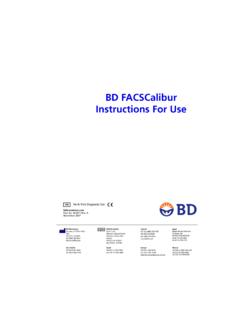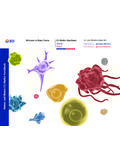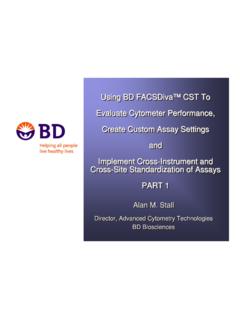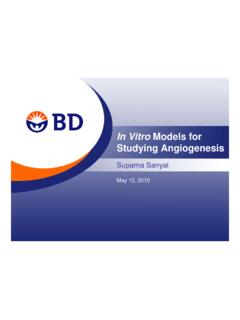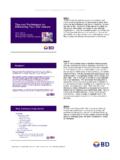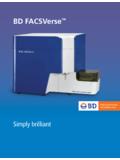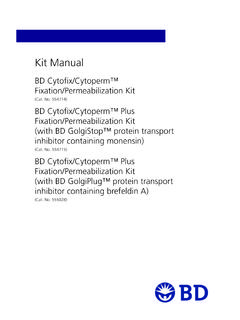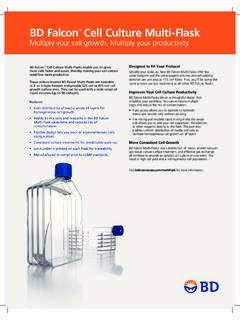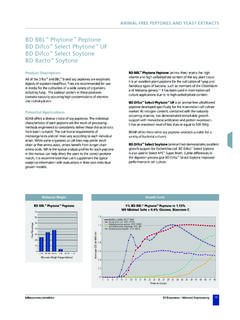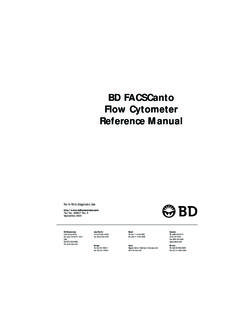Transcription of BD FACS Lysing Solution - BD Biosciences - Choose …
1 1 Becton, Dickinson and CompanyBD Biosciences2350 Qume DriveSan Jose, CA 95131 USAB enex LimitedPottery Road, Dun Laoghaire,Co. Dublin, IrelandTel + + BiosciencesEuropean Customer SupportTel + Dickinson Pty Ltd,4 Research Park Drive,Macquarie University Research Park,North Ryde NSW 2113, AustraliaBecton Dickinson Limited,8 Pacific Rise, Mt. Wellington,Auckland, New ZealandBD, BD Logo and all other trademarks are property of Becton, Dickinson and Company. 2015 BDIVD02/201523-1358-08 facs Lysing Solution 100 mL Catalog No. 3492021. INTENDED USEBD facs Lysing Solution is intended for Lysing red blood cells following direct immunofluorescence staining of human peripheral blood cells with monoclonal antibodies prior to flow cytometric facs Lysing Solution is appropriate for use with reagents such as BD Tritest or BD Simultest reagents and a suitably equipped flow cytometer. It may be used in both lyse/wash and lyse/no-wash SUMMARY AND EXPLANATIONE fficient detection of lymphocytes in peripheral blood depends on the elimination of interfering cells.
2 Whole blood lysis has been shown to be as effective as density gradient centrifugation in the preparation of peripheral blood mononuclear cells (PBMCs) for lymphocyte subset In clinical laboratories, whole blood lysis methods have essentially replaced Ficoll-Paque * density gradient separation because of shorter sample preparation time and less handling of whole Studies have also shown that the lysed whole blood method is less likely to show loss of lymphocyte subsets and may help improve assay reproducibility when compared to earlier PRINCIPLES OF THE PROCEDUREWhen whole blood is added to the monoclonal antibody reagent, the fluorochrome-labeled antibodies in the reagent bind specifically to leucocyte surface antigens. The stained samples are then treated with BD facs Lysing * Ficoll-Paque is a trademark of GE , which lyses erythrocytes under gentle hypotonic conditions while preserving the REAGENTR eagent ProvidedBD facs Lysing Solution , 10X concentrate, is provided as 100 mL of a proprietary buffered Solution containing <15% formaldehyde and <50% diethylene glycol.
3 This quantity is sufficient for 2,000 tests when used in BD lyse/no-wash procedures (for example, BD Tritest), and for 500 tests when used in lyse/wash procedures (for example, BD Simultest).Precautions For In Vitro Diagnostic Use. Reagent contains diethylene glycol, CAS number 111-46-6, formaldehyde, CAS number 50-00-0, and methanol, CAS number biological specimens and materials coming in contact with them are considered biohazards. Handle as if capable of transmitting infection8,9 and dispose of with proper precautions in accordance with federal, state, and local regulations. Never pipette by mouth. Wear suitable protective clothing, eyewear and InstructionsDilute the 10X concentrate 1:10 with room temperature (20 C 25 C), deionized water. The prepared Solution is stable for 1 month when stored in a glass or high density polyethylene (HDPE) container at room STORAGE AND HANDLINGBD facs Lysing Solution (10X) is stable until the expiration date shown on the bottle label when stored as directed.
4 Do not use this reagent if discoloration occurs or a precipitate INSTRUMENTBD facs Lysing Solution is designed for flow cytometers equipped with appropriate computer hardware and software. The flow cytometer must be equipped to detect forward scatter (FSC) and side scatter (SSC). We recommend a BD FACSC alibur , BD FACSC anto , or DangerH311 Toxic in contact with skin. H331 Toxic if inhaled. H341 Suspected of causing genetic defects. H350 May cause cancer. Route of exposure: May cause damage to organs. May cause respiratory May cause damage to the kidneys through prolonged or repeated exposure. Route of exposure: Causes serious eye damage. H302 Harmful if Causes skin May cause an allergic skin protective clothing / eye protection. Wear protective gloves. Avoid breathing mist/ IN EYES: Rinse cautiously with water for several minutes. Remove contact lenses, if present and easy to do. Continue rinsing.
5 IF INHALED: Remove victim to fresh air and keep at rest in a position comfortable for breathing. IF SWALLOWED: Immediately call a doctor. Danger3BD FACSC anto II flow cytometer. However, results may be achieved using other platforms. Refer to the appropriate reagent instructions for use (IFU) for specific instrument SPECIMEN COLLECTION AND PREPARATIONC ollect blood aseptically by venipuncture10,11 into a sterile BD Vacutainer EDTA blood collection tube. Follow the collection tube manufacturer s guidelines for the minimum volume of blood to be collected. Store anticoagulated blood at room temperature (20 C 25 C) until ready for staining and Lysing . Refer to the appropriate reagent IFU for storage restrictions prior to staining. See Section 10, Limitations, for possible interfering PROCEDURER eagent ProvidedBD facs Lysing Solution , 10X concentrate (Catalog No. 349202)Reagents and Materials Required but Not Provided 1X BD facs Lysing Solution , diluted as indicated in Section 4, Reagent: Dilution instructions BD Vacutainer EDTA blood collection tubes, or equivalent Disposable 12 x 75-mm capped polystyrene test tubes BD monoclonal antibodies to human leucocyte antigens (for example, BD Tritest or BD Simultest reagents) Vortex mixer Micropipettor with tipsOther materials can be required.
6 Refer to the appropriate reagent IFU for more SamplesStain whole blood samples following instructions in the appropriate reagent IFU. Lyse red blood cells as directed using diluted (1X) BD facs Lysing Solution . Use care to protect the tubes from direct light. Perform the procedure at room temperature (20 C 25 C).1. For each sample, combine appropriate amounts of fluorochrome-conjugated monoclonal antibody reagent and blood per tube as directed in the specific Incubate the tubes as Add an appropriate volume of 1X BD facs Lysing Solution to the tubes as directed. Vortex Continue as directed in the specific IFU until the cells are ready to be acquired on the flow cytometer. Cap the tubes and store at 2 C 8 C in the dark until flow cytometric analysis. Analyze the stained cells within the time limit specified in the appropriate IFU. Vortex the cells thoroughly at low speed to reduce aggregation before RESULTSThe following representative data was obtained with peripheral blood samples treated with BD facs Lysing Solution on a BD FACScan flow cytometer.
7 The whole blood was stained with BD Tritest CD3/CD4/CD45 reagent (Figure 1) or BD Simultest CD3/CD4 reagent (Figure 2).4 Figure 1CD45 vs SSC and CD3 vs CD4 dot plots obtained with BD Tritest reagentFigure 2 FSC vs SSC and CD3 vs CD4 dot plot obtained with BD Simultest reagent10. LIMITATIONS Laboratories must establish their own normal reference ranges for each reagent parameter that can be affected by sex of patient, age of patient, and preparative technique. Race of patient may also have an effect,12 although sufficient data is not available to establish this. Age, sex, clinical characteristics, and race of subjects should be known when a reference range is Reference ranges provided are for information only. BD facs Lysing Solution is specifically formulated for use with BD facs brand flow cytometers. EDTA is the anticoagulant of choice. BD has limited information concerning use of other anticoagulants such as heparin.
8 Retain samples in BD Vacutainer EDTA blood collection tubes at room temperature (20 C 25 C) prior to staining and Lysing . Refer to the reagent IFU for maximum storage times after collection. Samples with nucleated red blood cells may show incomplete lysis of red blood cells because BD facs Lysing Solution does not lyse nucleated erythrocytes. This may also occur when assaying blood samples from patients with certain hematologic disorders in which red cells are difficult to lyse, as in myelofibrosis, sickle-cell anemia, thalassemia, and ,8 When using monoclonal reagents that react with serum immunoglobulins, blood samples should be washed with 1X phosphate buffered saline (PBS) or physiological saline prior to staining and A monoclonal reagent against a cell surface antigen or receptor that is: a) shed into plasma (for example, IL-2 receptor) or b) occupied by plasma components (for example, complement receptors) can have reduced staining intensity when analyzed with the lysed whole blood EXPECTED VALUESN ormal subjects were studied at three clinical sites to establish reference ranges for the CD3+ and CD3+CD4+ lymphocyte subsets.
9 The reference ranges for the parameters studied are presented in the following table. The ranges obtained were tested for differences by site, sex, and age of subject. If the comparison indicated a significant difference, separate ranges were SubsetSexAgenMean95% Range% CD3+Both18 701607259 855 Adult reference ranges should not be used with pediatric blood samples (ages neonate to 13 years). Refer to the first limitation for more information about reference PERFORMANCE CHARACTERISTICSP recisionFor the BD Tritest (CD3/CD4/CD45) reagent, specimens from 17 normal and 61 abnormal donors were obtained at two clinical sites. Three aliquots of each specimen were stained, lysed, and run on BD FACScan flow the BD Simultest (CD3/CD4) reagent, within-specimen reproducibility was assessed at one clinical site. Determinations were made on blood specimens from six normal and four patient subjects (HIV and renal transplant).
10 Two aliquots from the same blood sample were prepared with the BD Simultest IMK Lymphocyte reagent panel and each aliquot was run twice on the same BD FACScan flow Cell RecoveryFive blood samples were treated with BD facs Lysing Solution , washed, and analyzed for white cell recovery using the Ortho ELT-1500 Clinical Hematology Analyzer. Compared to the total white blood cell count, white cell recovery with the Lysing Solution averaged 92%.Red Blood Cell LysisFive blood samples were treated with BD facs Lysing Solution , washed, and analyzed for residual red blood cells using the Ortho ELT-1500 Clinical Hematology Analyzer. No red blood cells were otherwise indicated in any applicable BD general conditions of sale for non-US customers, the following warranty applies to the purchase of these PRODUCTS SOLD HEREUNDER ARE WARRANTED ONLY TO CONFORM TO THE QUANTITY AND CONTENTS STATED ON THE LABEL OR IN THE PRODUCT LABELING AT THE TIME OF DELIVERY TO THE CUSTOMER.
